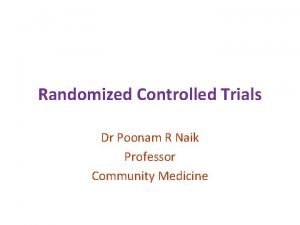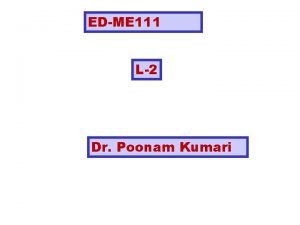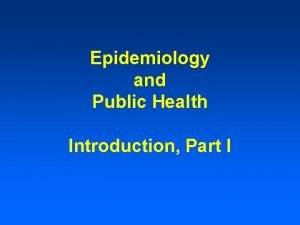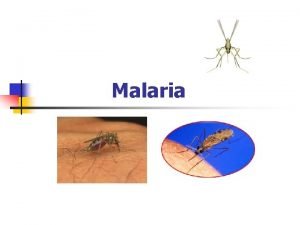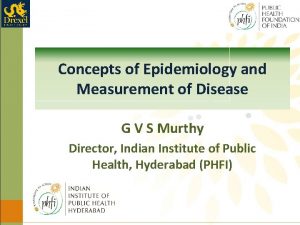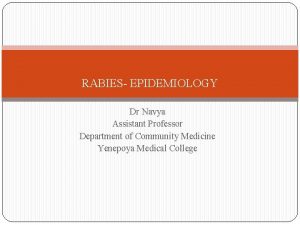Epidemiology Dr Poonam R Naik Professor Department of















- Slides: 15

Epidemiology Dr Poonam R Naik Professor Department of Community Medicine

Review Ø Definition Ø Basic Measurements in epidemiology Ø Morbidity rates Ø Epidemiologic methods: 1. Observational: Descriptive and Analytical 2. Experimental: RCT, Field Trials and Community Trials

Examples 1. Prevalence of depression among elderly in a rural field practice area. 2. Methodology: A study of acute myocardial infarction with 27 098 participants in 52 countries (12 461 cases and 14 637 controls) representing several major ethnic groups. We assessed the relation between BMI, waist and hip circumferences, and waist-to-hip ratio to myocardial infarction overall and for each group.

Uses of epidemiology 1. To study historically the rise and fall of disease in the population 2. Community diagnosis 3. Planning and Evaluation 4. Evaluation of individual’s risks and chances 5. Completing the natural history of disease 6. Searching for causes and risk factors

Infectious Disease Epidemiology

Terminologies 1. Infection: Entry and development or multiplication of an infectious agent in the body of man or animals. Response of the body: 2. Contamination: Presence of infectious material 3. Pollution: Presence of offensive material

4. Infectious Disease: Clinically manifest disease resulting from an infection 5. Contagious disease: Disease transmitted through contact. 6. Communicable disease: Disease due to specific infectious agent which can be transmitted either directly or indirectly.

3. Epidemic: The unusual occurrence of a disease in a community or region clearly in excess of expected occurrence. 4. Endemic: Refers to the constant presence of a disease within a given geographic area without importation from outside.

5. Sporadic: Scattered about. Cases occur irregularly, haphazardly from time to time. 6. Pandemic: Epidemic affecting a larger part of the population occurring over a wide geographic area.

7. Zoonotic Diseases: Infectious diseases transmissible under natural conditions from vertebrate animals to man. 8. Epizootic 9. Enzootic 10. Epornithic

11. Nosocomial infection: Infection originates in a patient while in a hospital or in a health care facility. Denotes a new disorder unrelated to the patient’s primary condition. 12. Opportunistic Infection: Infection by an organism which takes the opportunity provided by a defect in host defence mechanism to infect the host and thus cause the disease.

Surveillance: Continuous scrutiny of the factors that determine the occurrence and distribution of disease and other conditions of ill health. Ø Includes collection and analysis of data for action. Ø Essential for effective control and prevention. Examples: 1. AFP surveillance 2. Malaria surveillance 3. HIV surveillance

Review 1. Explain: Infection, Contamination and Pollution 2. Explain: Infectious disease, Contagious disease and Communicable disease. 3. Explain: Epidemic, Endemic, Sporadic and Pandemic

Correct the error: 1. Nosocomial Infection: Infections caused due to complications of the patient’s disease. 2. Epornithic: Endemic disease in animal population.

Justify the statement Opportunistic infections are common in patients infected with HIV.
 Poonam naik
Poonam naik Poonam naik
Poonam naik Lagu naik naik tangga ukuran
Lagu naik naik tangga ukuran How dr. wafaa elsadr epidemiology professor
How dr. wafaa elsadr epidemiology professor How dr. wafaa elsadr epidemiology professor
How dr. wafaa elsadr epidemiology professor Regenerative braking ppt
Regenerative braking ppt Dr poonam sinha
Dr poonam sinha Dr poonam kumari
Dr poonam kumari Dr poonam agarwal
Dr poonam agarwal Poonam's day out solution
Poonam's day out solution Promotion from associate professor to professor
Promotion from associate professor to professor Attack rate epidemiology formula
Attack rate epidemiology formula Attack rate calculation
Attack rate calculation Define epidemiology
Define epidemiology People infected
People infected Distribution in epidemiology
Distribution in epidemiology

